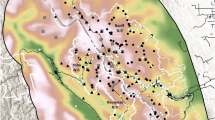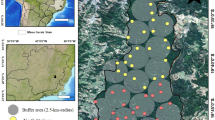Abstract
The snow leopard Panthera uncia is an elusive and globally-threatened apex predator occurring in the mountain ranges of central Asia. As with other large carnivores, gaps in data on its distribution and abundance still persist. Moreover, available density estimates are often based on inadequate sampling designs or analytical approaches. Here, we used camera trapping across a vast mountainous area (area of the sampling frame 850 km2; analysed habitat extent 2600 km2) and spatially-explicit capture-recapture (SECR) models to provide, to our knowledge, the first robust snow leopard population density estimate for the Altai Mountains. This region is considered one of the most important conservation areas for snow leopards, representing a vast portion of suitable habitat and a key ecological corridor. We also provide estimates of the scale parameter (σ) that reflects ranging behaviour (activity range) and baseline encounter probability, and investigated potential drivers of density and related parameters by assessing their associations with anthropogenic and environmental factors. Sampling yielded 9729 images of snow leopards corresponding to 224 independent detections that belonged to a minimum of 23 identified adult individuals. SECR analysis resulted in an overall density of 1.31 individuals/100 km2 (1.15%–1.50 95% CI), which was positively correlated with terrain slope. This estimate falls within the mid-values of the range of density estimates for the species globally. We estimated significantly different activity range size for females and males (79 and 329 km2, respectively). Baseline encounter probability was negatively associated with anthropogenic activity. Our study contributes to on-going efforts to produce robust global estimates of population abundance for this top carnivore.




Similar content being viewed by others
Data availability
The datasets generated and analysed during the current study is available in the Figshare repository https://figshare.com/s/0d21087ff37e3257d5aa.
References
Alexander JS, Gopalaswamy AM, Shi K, Riordan P (2015) Face value: towards robust estimates of snow leopard densities. PLoS One 10:e0134815
Alexander JS, Zhang C, Shi K, Riordan P (2016a) A granular view of a snow leopard population using camera traps in Central China. Biol Cons 197:27–31
Alexander JS, Gopalaswamy AM, Shi K, Hughes J, Riordan P (2016b) Patterns of snow leopard site use in an increasingly human-dominated landscape. PLoS One 11:e0155309
Anile S, Amico C, Ragni B (2012) Population density estimation of the European wildcat (Felis silvestris silvestris) in Sicily using camera trapping. Wildl Biol Pract 8:1–12
Augugliaro C, Christe P, Janchivlamdan C, Baymanday H, Zimmermann F (2020) Patterns of human interaction with snow leopard and co-predators in the Mongolian western Altai: current issues and perspectives. Glob Ecol Conserv 24:e01378
Burnham KP, Anderson DR (2002) Model Selection and Multi-Model Inference. A Practical Information-Theoretic Approach, 2nd edn. Springer, New York
Chetri M, Odden M, Sharma K, Flagstad Ø, Wegge P (2019) Estimating snow leopard density using fecal DNA in a large landscape in north-central Nepal. Global Ecol Conserv 17:e00548
Efford MG, Fewster RM (2013) Estimating population size by spatially explicit capture–recapture. Oikos 122:918–928
Efford M (2020). secr: Spatially explicit capture-recapture models. R package version 4.3.3. https://CRAN.R-project.org/package=secr. Accessed 1 March 2021
Gimenez O, Gatti S, Duchamp C, Germain E, Laurent A, Zimmermann F, Marboutin E (2019) Spatial density estimates of Eurasian lynx (Lynx lynx) in the French Jura and Vosges Mountains. Ecol Evol 9:11707–11715
Hacker CE, Jevit M, Hussain S, Muhammad G, Munkhtsog B, Munkhtsog B et al (2021) Regional Comparison of Snow Leopard (Panthera uncia) Diet using DNA Metabarcoding. Biodiv Conserv. https://doi.org/10.1007/s10531-021-02118-6
Harmsen BJ, Foster RJ, Quigley H (2020) Spatially explicit capture recapture density estimates: robustness, accuracy and precision in a long-term study of jaguars (Panthera onca). PLoS ONE 15:e0227468
Hijmans RJ (2020) raster: Geographic Data Analysis and Modeling. R package version 3.0–12. https://CRAN.R-project.org/package=raster. Accessed 1 March 2021
Jackson RM (1996) Home range, movements and habitat use of snow leopard (Uncia uncia) in Nepal. Doctoral dissertation, University of London, London
Janečka JE, Munkhtsog B, Jackson RM, Naranbaatar G, Mallon DP, Murphy WJ (2011) Comparison of noninvasive genetic and camera-trapping techniques for surveying snow leopards. J Mammal 92:771–783
Janecka JE, Zhang Y, Li D, Munkhtsog B, Bayaraa M, Galsandorj N, Naraanbatar G et al (2017) Range-wide snow leopard phylogeography supports three subspecies. J Hered 108:597–607
Johansson Ö, Rauset GR, Samelius G, McCarthy T, Andrén H, Tumursukh L et al (2016) Land sharing is essential for snow leopard conservation. Biol Conserv 203:1–7
Johansson Ö, Koehler G, Rauset GR, Samelius G, Andrén H, Mishra C et al (2018) Sex-specific seasonal variation in puma and snow leopard home range utilization. Ecosphere 9:e02371
Kachel SM, McCarthy KP, McCarthy TM, Oshurmamadov N (2017) Investigating the potential impact of trophy hunting of wild ungulates on snow leopard Panthera uncia conservation in Tajikistan. Oryx 51:597–604
Karanth KU, Nichols JD (1998) Estimation of tiger densities in India using photographic captures and recaptures. Ecology 79:2852–2862
Li J, Weckworth BV, McCarthy TM, Liang X, Liu Y, Xing R et al (2020) Defining priorities for global snow leopard conservation landscapes. Biol Conserv 241:108387
Lukarevskiy VS, Dalannast M, Lukarevskiy S, Damdin E (2019) Factors Determining the Distribution and Status of the Snow Leopard Population (Panthera uncia) in Western Mongolia. Animal and Veterinary Sciences 7:127
McCarthy TM, Fuller TK, Munkhtsog B (2005) Movements and activities of snow leopards in Southwestern Mongolia. Biol Conserv 124:527–537
McCarthy KP, Fuller TK, Ming M, McCarthy TM, Waits L, Jumabaev K (2008) Assessing estimators of snow leopard abundance. J Wildlife Manage 72:1826–1833
McCarthy T, Mallon D, Sanderson EW, Zahler P, Fisher K (2016) What is a snow leopard? Biogeography and status overview. In: McCarthy T, Mallon D (eds) Snow leopards. Academic Press, pp 23–42
McCarthy T, Mallon D, Jackson R, Zahler P, McCarthy K (2017) Panthera uncia. The IUCN Red List of Threatened Species. https://dx.doi.org/https://doi.org/10.2305/IUCN.UK.2017-2.RLTS.T22732A50664030.en. Accessed 17 September 2021
R Core Team (2020) R: A language and environment for statistical computing. R Foundation for Statistical Computing, Vienna, Austria. https://www.R-project.org/
Reading RP, Amgalanbaatar S, Kenny D, DeNicola A, Tuguldur E (2007) Siberian ibex (Capra sibirica) home ranges in Ikh Nart Nature Reserve, Mongolia: preliminary findings. Mongolian Journal of Biological Sciences 5:29–36
Riordan P, Cushman SA, Mallon D, Shi K, Hughes J (2016) Predicting global population connectivity and targeting conservation action for snow leopard across its range. Ecography 39:419–426
Rovero F, Kays R (2021) Camera trapping for conservation. In: Wich S, Piel A (eds) Conservation technology. Oxford University Press, Oxford, pp 79–101
Royle JA, Chandler RB, Sollmann R, Gardner B (2013) Spatial capture-recapture. Academic Press, USA
Royle JA, Fuller AK, Sutherland C (2016) Spatial capture–recapture models allowing Markovian transience or dispersal. Popu Ecol 58:53–62
Salvatori M, Tenan S, Oberosler V, Augugliaro C, Christe P, Groff C et al (2021) Co-occurrence of snow leopard, wolf and Siberian ibex under livestock encroachment into protected areas across the Mongolian Altai. Biol Conserv 261:109294
Sandell M (1989) The mating tactics and spacing patterns of solitary carnivores. In: Gittleman JL (ed) Carnivore Behavior, Ecology, and Evolution. Springer, Boston, pp 164–182
Sharma S, Dutta T, Bhatnagar Y (2006) Marking site selection by free ranging snow leopard (Panthera uncia). In: McNeely JA, McCarthy TM, Smith A, Olsvig-Whittaker L, Wikramanayake ED (eds) Conservation Biology in Asia. Society for Conservation Biology Asia Section and Resources Himalaya, Kathmandu, pp 197–213
Sharma K, Bayrakcismith R, Tumursukh L, Johansson O, Sevger P, McCarthy T, Mishra C (2014) Vigorous dynamics underlie a stable population of the endangered snow leopard Panthera uncia in Tost Mountains, South Gobi. Mongolia. PloS one 9(7):e101319
Sharma RK, Sharma K, Borchers D, Bhatnagar YV, Suryawanshi KR, Mishra C (2021) Spatial variation in population-density of snow leopards in a multiple use landscape in Spiti Valley, Trans-Himalaya. PloS One 16:e0250900
Sharma K, Borchers D, Mackenzie D, Durbach I, Sutherland C, Nichols JD et al (2019) Guidelines for estimating snow leopard abundance and distribution using a combination of spatial capture-recapture and occupancy models. Submitted to the Steering Committee of the Global Snow Leopard and Ecosystem Protection Program; with financial support from Global Environment Facility, United Nations Development Program and Snow Leopard Trust, pp 54. https://snowleopardnetwork.org/wp-content/uploads/2020/08/PAWS-guidelines-2020.pdf. Accessed 1 September 2021
Snow Leopard Network 2014. Snow Leopard Survival Strategy. Revised 2014 Version. Snow Leopard Network, Seattle, Washington
Suryawanshi KR, Khanyari M, Sharma K, Lkhagvajav P, Mishra C (2019) Sampling bias in snow leopard population estimation studies. Popul Ecol 61:268–276
Acknowledgements
We are grateful to two anonymous reviewers for constructive comments on the manuscript. We are grateful to the Ministry of Environment and Tourism of Mongolia for research permits and support, and to C. Janchivlamdan of Wildlife Initiative for logistic support. We also thank the following colleagues, field assistants, translators and rangers for invaluable help during the fieldwork: R. Rizzoli, P. Zorer, B. Barsuren, B. Munkh-Erdene, T. Yondonjamts, H. Baymanday and J. Khuantkan. We are grateful to S. Palmarini and R. Rizzoli also for their help with photo processing and/or snow leopard identifications. We thank P. Christie and F. Zimmermann for support to the project and lending a portion of camera traps. M. Efford kindly provided statistical advice.
Funding
This research was supported by Panthera Sabin Snow Leopard grants, Arca Foundation—Parco Natura Viva, Wildlife Initiative, Irbis Mongolia and the Altai institute for research and conservation. The Gino Zobele Fund supported V.O., the Herbette Foundation from the University of Lausanne supported C.A., and M.K. was supported by the Slovenian Research Agency (grants P4-0059 and N1-0163).
Author information
Authors and Affiliations
Contributions
FR, CA, VO, ST and CG designed the study. MK, CG, VO and FR collected the data. VO and ST analysed the data. VO led the writing of the manuscript to which all authors contributed critically and gave final approval for publication.
Corresponding author
Ethics declarations
Conflict of interest
The authors declare that there is no conflict of interest and that this material has not been submitted for publication elsewhere.
Additional information
Communicated by Grzegorz Mikusinski.
Publisher's Note
Springer Nature remains neutral with regard to jurisdictional claims in published maps and institutional affiliations.
Appendices
Appendix A
See Table 3.
Appendix B
See Table 4.
Rights and permissions
About this article
Cite this article
Oberosler, V., Tenan, S., Groff, C. et al. First spatially-explicit density estimate for a snow leopard population in the Altai Mountains. Biodivers Conserv 31, 261–275 (2022). https://doi.org/10.1007/s10531-021-02333-1
Received:
Revised:
Accepted:
Published:
Issue Date:
DOI: https://doi.org/10.1007/s10531-021-02333-1




